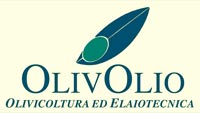
|
|
OIL QUALITY -PRODUCTION TECHNIQUES
|
CHEMICAL
& NATURAL CHARACTERISTICS
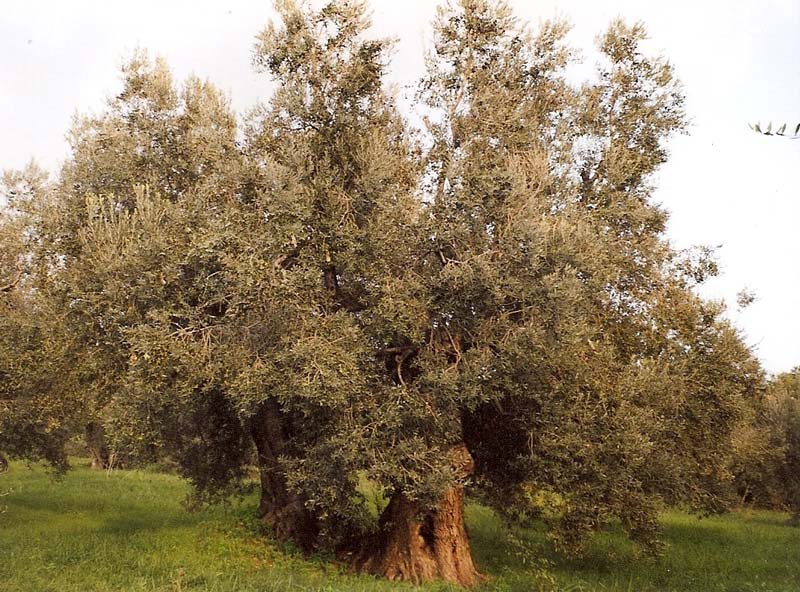
STUDY OF CHEMICAL AND NATURAL CHARACTERISTICS OF EXTRA VIRGIN OLIVE OIL
-
Chemical Analysis
-
Complete Study for Improved Quality and
Characterisation of the Product
-
Individual or Group Courses for Olive Oil Tasting
according to the Norms of the International Olive Oil Council (Qualified
International Panel Supervisor)
-
Systems and Machinery for
Pressing and Extraction.
-
The Study of Influences of
different Systems and Machinery on the Olive Oil Quality
for adjusting the characteristics of Final Product.
-
Functional Solution for different Systems and Machinery
types.
-
Planing for New Olive Oil
Mills (Frantoio) or Restructuring of the already Existing Mills.
VARIETIES
At this stage it is important to point out that each variety produces
a "monocultivar" oil generally characterised by a marked organoleptic
typicality, in other words by its own specific taste, also influenced
by the pressing and extraction systems utilised.
While still in Tuscany, we should also point out for example, that the
oil of the Leccino variety tends to be "sweeter" in
comparison to that of the Frantoio variety, which is instead
more "fruity", and also more "pungent" and "bitter".
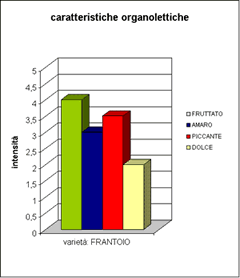
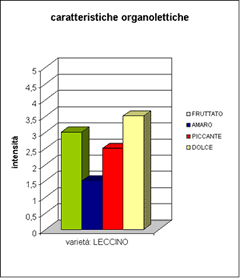
Fruitiness, bitterness, pungency, sweetness represent the most important
sensory attributes of olive oil and may vary considerably depending
on the cultivars (in Tuscany alone approximately 80 have been identified
up to date).
Moreover, these varieties often present very marked differences, also
deriving from their ripening periods.
The Leccino for example, is a precocious variety while the Moraiolo,
another classic Tuscan cultivar, is a late ripener. In a modern and
rational olive growing business it is most important to divide the various
cultivars into sectors in order to be able carry out a differentiated
picking in line with the ripening, and thus obtain perfect mono-variety
oils with different characteristics, after which it will be the olive
oil producer's responsibility to formulate the most appropriate mixtures
according to the company's requirements.
Consequently, you must also keep these organoleptic diversities in mind
when planning a new system, as well as evaluate the markets demands
and trends, in striving for a product "typicality", increasingly
more important for leaving the masses behind and creating your own commercial
strategy. For this purpose it is essential for only olive saplings of
certain origin to be purchased, even better if certified
and guaranteed both from a genetic and phyopathological point of view.
Despite their higher unitary costs, the precocious entering into production,
constant productivity, and specific genetic characteristics like higher
resistance to natural adversities of certain "clones", will
more than repay the careful olive grower.
TRASFORMIG TECHNIQUES
The final organoleptic characteristics of olive oil (in other words,
the flavour), are the result of various factors:
the production ecosystem (soil, altitude, climate), the olive
varieties (and their degree of ripening), and lastly, the pressing
and extracting techniques. Likewise with the ecosystem and variety,
by intervening on the pressing and extracting techniques, the
organoleptic profile of a product can be radically altered.
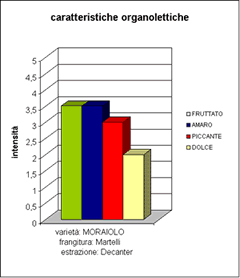
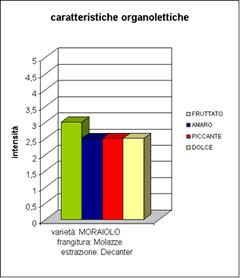
The main olive transforming phases are as follows:
Washing and ventilating: to remove leaves and impurities.
Pressing: mechanical pressing of the olives.
Kneading: homogenisation of the paste obtained.
Extraction: of the liquid part (mixture of water and oil) from the solid part (olive residues).
Separation: of the oil from the vegetation water.
The pressing system in particular (meaning the different mechanical pressing methods), that the olive skin, pulp and stone are subjected to has the greatest effect on the organoleptic profile of the oil.
Stone Muller and Rollers: exalt the Sweetness and the Yellow-gold colour
Hammer press: exalt the Bitterness and the Green-gold colour
Cogged disc press: exalt the Pungency and the Brilliant green colour
The Extraction phase is also a determining factor with regard to the organoleptic profile and may be of the following types:
Traditional: or by pressure with a fiscoli press.
Modern: or centrifuge with decanter.
Sinolea: or by percolation and double extraction.
Very different results are obtained from each of these
systems, with respect to both the chemical and organoleptic characteristics
and also the density and appearance of the product. With the modern
kneading-decanter systems we can also intervene with other parameters
like kneading times, temperature of the paste, and percentage of water
added in the decanter, all relevant in our quest for the highest
quality.
On summing up this brief description about how transformation techniques
can greatly influence the final "flavour" of the product,
and on the basis of my experience and experimentation with almost every
type of mono-variety oil system in existence for the major Tuscan
cultivars,
I wish to point out how even the different oil-producing machinery manufacturers
contribute towards the characterisation to the product. To be more precise,
if we use the same crop of olives and the same type of machinery, produced
however by different manufacturers, we often obtain completely different
olive oils.
The technical themes described above are of quite recent acquisition
and still in the process of being studied and analysed by the most important
researchers and experts in this sector, however, from all this it appears
clear that the variables regarding the differentiation and research
for the highest product quality are many and varied.
The careful producer, by starting out with a specific ecosystem, can
intervene on the varieties, targeting the ones that are most suited
to his own type of product. Lastly, by choosing the most appropriate
transformation system (and most suitable manufacturer), he will be able
to exalt certain characteristics and tone down others, for the purpose
of highlighting the aftertastes and hidden aromas, and thus be able
to perfect his own product in his quest for the best possible commercial
strategy.
Mills Photo Gallery (click here to open)